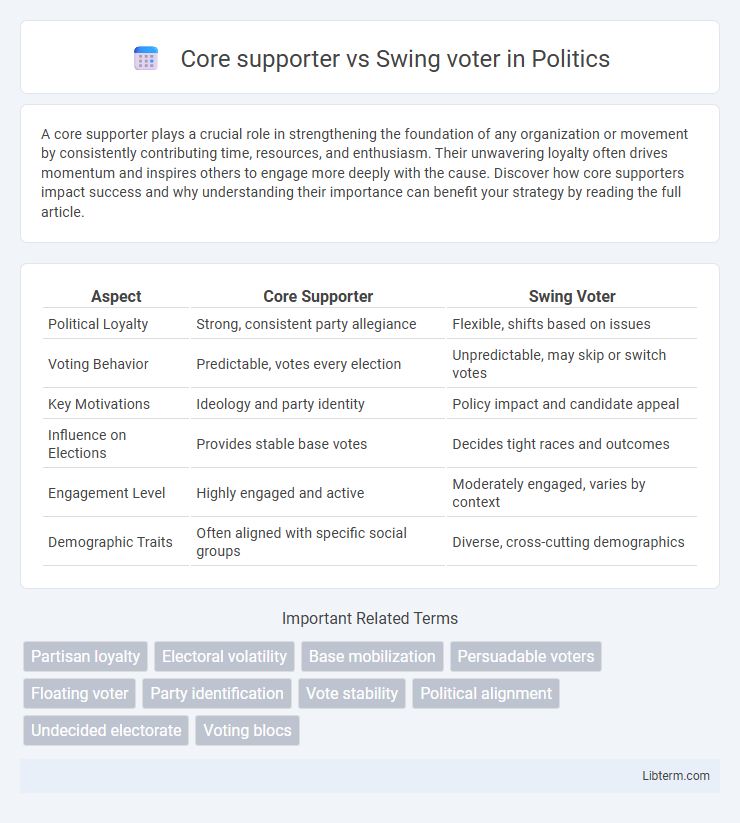A core supporter plays a crucial role in strengthening the foundation of any organization or movement by consistently contributing time, resources, and enthusiasm. Their unwavering loyalty often drives momentum and inspires others to engage more deeply with the cause. Discover how core supporters impact success and why understanding their importance can benefit your strategy by reading the full article.
Table of Comparison
| Aspect | Core Supporter | Swing Voter |
|---|---|---|
| Political Loyalty | Strong, consistent party allegiance | Flexible, shifts based on issues |
| Voting Behavior | Predictable, votes every election | Unpredictable, may skip or switch votes |
| Key Motivations | Ideology and party identity | Policy impact and candidate appeal |
| Influence on Elections | Provides stable base votes | Decides tight races and outcomes |
| Engagement Level | Highly engaged and active | Moderately engaged, varies by context |
| Demographic Traits | Often aligned with specific social groups | Diverse, cross-cutting demographics |
Understanding Core Supporters
Core supporters exhibit unwavering loyalty to political parties, consistently voting and advocating for their chosen candidates. Their strong ideological alignment and active engagement provide a reliable foundation for campaign strategies and fundraising efforts. Understanding core supporters helps parties tailor messages, mobilize grassroots efforts, and maintain a stable voter base amidst electoral fluctuations.
Defining Swing Voters
Swing voters are individuals who do not have a consistent allegiance to a single political party and often decide elections by shifting support between candidates based on current issues or campaign appeals. Unlike core supporters who maintain strong, predictable loyalty to a party, swing voters evaluate policies, candidate personalities, and performance before casting their ballots. Their unpredictable voting patterns make them a critical target for political campaigns aiming to secure electoral victories.
Key Characteristics of Core Supporters
Core supporters demonstrate unwavering loyalty to a political party or candidate, consistently voting along party lines regardless of changing political climates. Their engagement often includes active participation in campaigns, grassroots organizing, and advocacy, reflecting deep ideological alignment and long-term commitment. This contrasts with swing voters, who exhibit more fluid voting behaviors influenced by specific issues, candidate appeal, or current events.
Traits of Swing Voters
Swing voters exhibit key traits including political ambivalence, a tendency to evaluate candidates based on current issues rather than party loyalty, and higher susceptibility to campaign influence through targeted messaging and media exposure. Unlike core supporters, swing voters often display fluctuating opinions and lower ideological commitment, making them crucial in tight electoral races. Their pragmatic approach to voting decisions emphasizes personal benefit and perceived candidate competence over partisan allegiance.
Motivations Behind Core Supporter Loyalty
Core supporters remain loyal due to deeply rooted ideological beliefs and consistent alignment with a party's values, driving unwavering commitment through emotional and identity-based connections. Their voting behavior is influenced by perceived policy benefits and long-term trust in party leadership, contrasting with swing voters who prioritize short-term issues and candidate appeal. Understanding core supporter motivations is crucial for campaigns aiming to maintain a reliable voter base amid shifting political landscapes.
Factors Influencing Swing Voter Decisions
Swing voter decisions are primarily influenced by economic conditions, candidate charisma, and current political events, which create a fluid voting landscape compared to the stable loyalty seen in core supporters. Media framing and social networks significantly shape their perceptions and issue prioritization, making information channels critical in mobilizing this group. Unlike core supporters who remain consistent due to ideological alignment, swing voters weigh policy impacts and candidate competence more pragmatically.
Electoral Impact: Core Supporters vs. Swing Voters
Core supporters provide a reliable voting base, consistently delivering substantial vote shares crucial for party stability during elections. Swing voters, representing approximately 10-15% of the electorate, hold significant influence as their shifting preferences can determine tightly contested races and overall electoral outcomes. Campaign strategies prioritize mobilizing core supporters for turnout while aggressively targeting swing voters through tailored messaging to maximize vote gains.
Campaign Strategies for Each Group
Campaign strategies targeting core supporters prioritize reinforcing loyalty through personalized messaging and consistent engagement on social media platforms, ensuring their turnout on election day. Swing voter campaigns emphasize issue-based appeals and tailored advertisements that highlight candidate pragmatism and bipartisan solutions, using data analytics to identify and address voter concerns. Ground operations for swing voters often include targeted canvassing and get-out-the-vote initiatives that maximize persuasion and mobilization in key battleground districts.
Challenges in Mobilizing Core Supporters and Swing Voters
Mobilizing core supporters presents challenges such as voter fatigue and complacency, as these individuals often feel their participation is guaranteed, resulting in lower turnout rates. Swing voters, however, require targeted messaging that addresses their diverse concerns and values, making it essential to craft nuanced campaign strategies to sway their decisions. Both groups demand distinct engagement approaches to maximize electoral impact and ensure effective voter mobilization.
Future Trends in Voter Behavior
Core supporters continue to exhibit strong loyalty to their preferred political parties, driven by entrenched ideological beliefs and identity politics. Swing voters increasingly rely on real-time data from social media and personalized campaign messages to make decisions, reflecting a shift toward issue-based and momentary influences. Emerging trends suggest the growing importance of microtargeting technologies and AI-driven analytics in capturing the evolving preferences of these dynamic voter segments.
Core supporter Infographic

 libterm.com
libterm.com